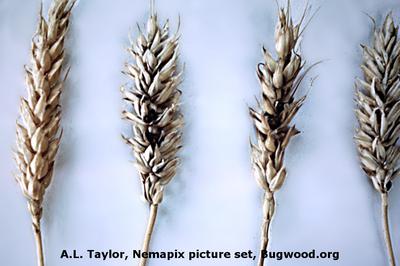Ear-cockle of Wheat
C/O: Anguina tritici
- Anguina tritici was the first plant parasitic nematode to be described in the literature in 1743.
- It causes a disease in wheat and rye called “ear-cockle” or seed gall.
Symptoms:
- Appear on leaves, stems, and heads (floral organs).
- The affected plants look dwarfed with twisted and crinkled leaves.
- Infected heads are shorter, broader, remain green for longer period, and contain hard, light to dark brown or black cockles (also called galls) replacing grains in the ear partially or completely.
- The awns are twisted and the ear is also very much twisted.
- The cockles remain filled with nematode larvae. When they are soaked in water and then macerated, one can see larvae coming out from them.
- It is an ectoparasite that becomes endoparasitic invading inflorescence and developing seeds.
- Stunted plants with distorted seed heads and flag leaves
- Leaves wrinkled, twisted and rolled.
- Stems swollen at ground level.
- At heading, plants are stunted with small seed heads that have open glumes.
- Grain replaced by hard brown black seed galls containing thousands of dry nematodes.

Favorable condition:
- Cool and moist climate is especially favorable for the development of this nematode.
- A film of moisture must be present when the young wheat plants are developing; otherwise, the very active larval nematodes cannot travel from the soil to the growing point of the seedling.
Survive and spread:
- Contaminated seed and contaminated soil.
- Primary source of inoculum: galled grains, which remain in the field at harvest or planted with the seed. Losses as high as 30- 70%.
- Secondary spread: no secondary spread has been reported.
Disease cycle:
- Second stage larvae lie quiescent in galled grains, which remain in the field at harvest or planted with the seed.
- They are liberated when released by moisture during favourable growing period and go in search of healthy plants growing nearby.
- They start crawling upwards on the roots of the young wheat plants and enter the young plumule from the top.
- As the plant grows, the larvae make their way to growing points, which will carry them upto, the seed head.
- Attacked grains become small, brown to black hard structures called galls.
- A gall is formed during the reaction of the seed tissue to the products of Slivery glands of nematodes.
- Total life cycle is completed in 113 days.

Management:
- Crop rotation with non-host crops for 1-2 years will eliminate nematodes, present in the field.
- Clean seed should be sown.
- Sieve Method (Mechanical) Sieves of different mesh sizes are used and galls are separated from the seed.
- Table Salt Solution: If sieving is not possible, prepare 20% solution of common table salt (NaCl).
- Hot water Treatment: Pre-soaking for 2 hours and then putting grains in hot water at 122°F (50ºC) for at least 2 hours. This method is also effective against the loose smut of wheat (Ustilago tritici).
- Resistant Varieties: Wheat of Mexican blood/origin is fairly resistant to the Disease.